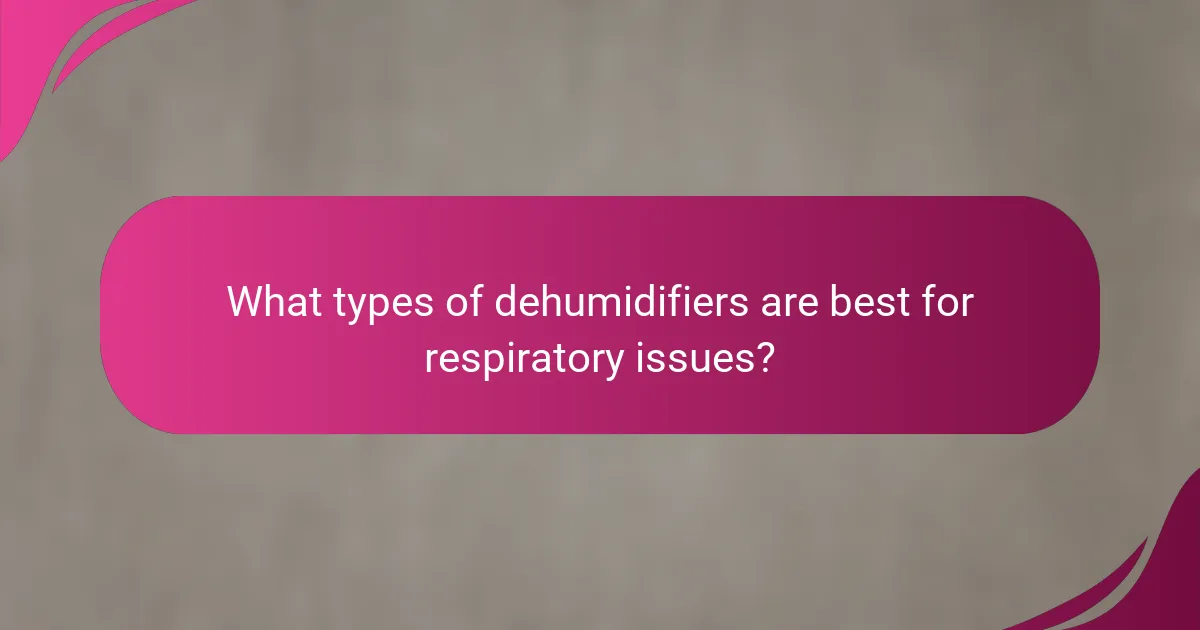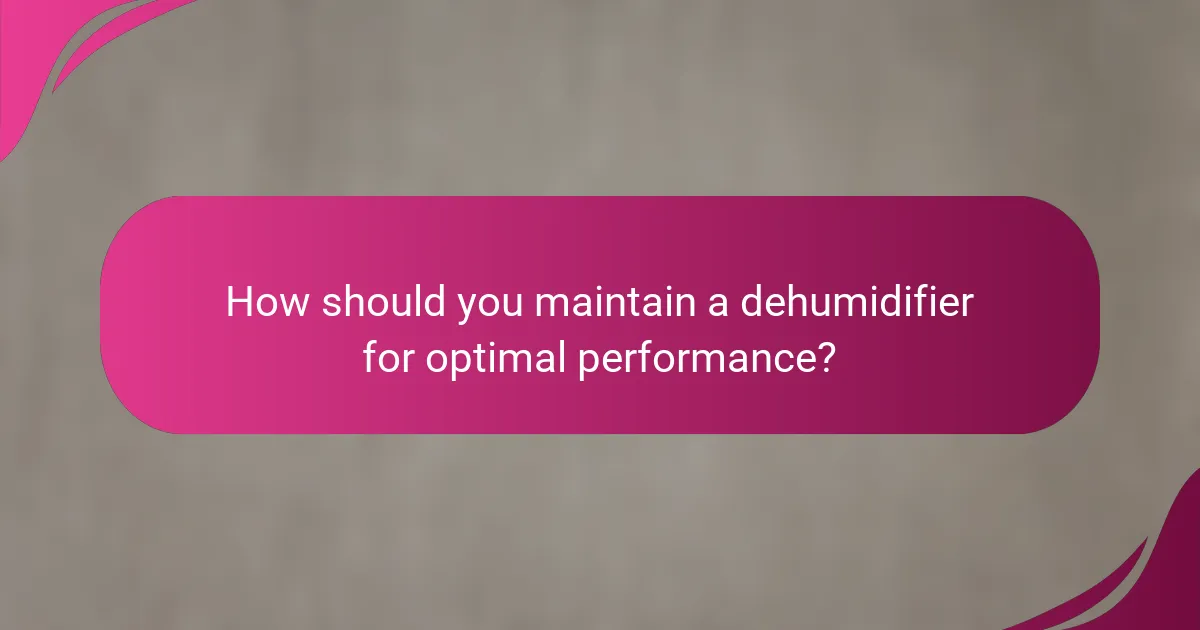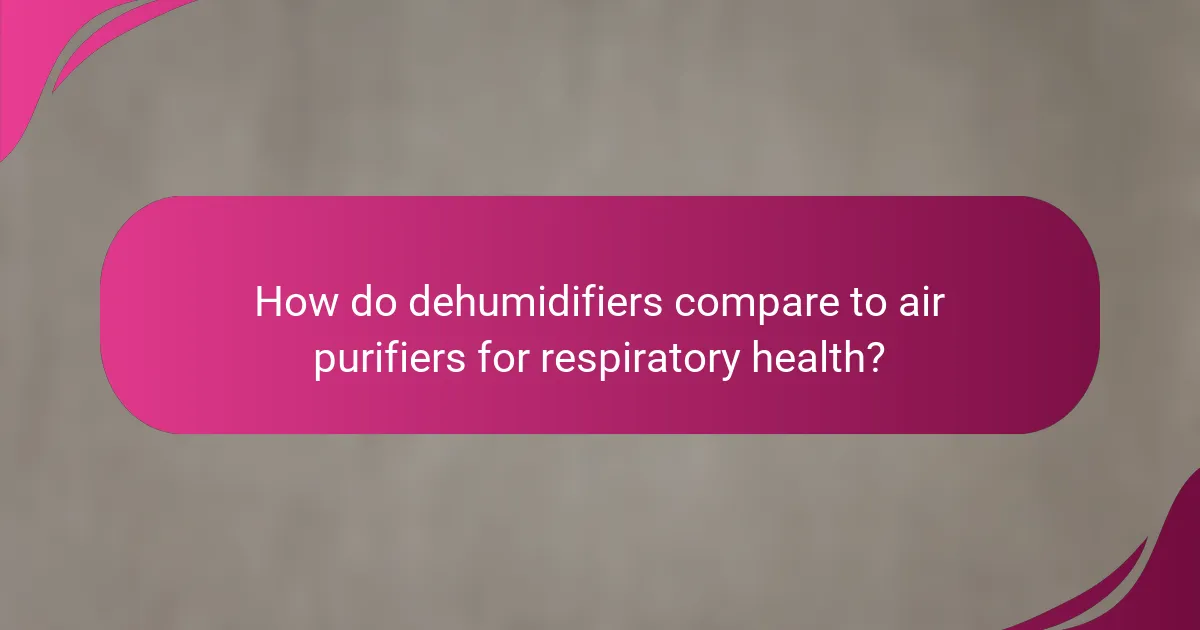Dehumidifiers play a crucial role in enhancing respiratory health by lowering humidity levels, which can significantly reduce allergens such as mold and dust mites. This is especially beneficial for individuals suffering from asthma or allergies, as it creates a healthier indoor environment. When choosing a dehumidifier, it’s important to consider factors like capacity, energy efficiency, and noise levels to ensure optimal performance and comfort.

How do dehumidifiers improve respiratory health in Canada?
Dehumidifiers enhance respiratory health in Canada by reducing humidity levels, which helps to minimize allergens like mold and dust mites. This creates a healthier indoor environment, particularly beneficial for individuals with asthma or allergies.
Reduction of mold spores
Dehumidifiers significantly lower humidity, which is crucial in preventing mold growth. Mold thrives in damp conditions, and by maintaining indoor humidity levels below 50%, dehumidifiers can inhibit mold spore proliferation.
In Canadian homes, especially in regions with high humidity, using a dehumidifier can drastically reduce mold-related respiratory issues. Regular monitoring of humidity levels can help ensure they remain optimal for health.
Decrease in dust mites
Dust mites flourish in humid environments, making dehumidifiers an effective tool for controlling their population. By lowering humidity, these devices can reduce dust mite allergens, which are common triggers for asthma and allergies.
In Canada, maintaining indoor humidity below 50% can lead to a significant decrease in dust mite presence, improving overall air quality and respiratory comfort. Regular cleaning and use of dehumidifiers can work together for better results.
Improved air quality
Dehumidifiers contribute to improved air quality by reducing moisture that can lead to the growth of allergens and irritants. Cleaner air can alleviate symptoms for those with respiratory conditions, enhancing overall well-being.
For Canadians, particularly in humid climates, using a dehumidifier can be a proactive step in maintaining a healthy living space. Regular maintenance of the unit ensures it operates efficiently, providing continuous benefits to indoor air quality.

What types of dehumidifiers are best for respiratory issues?
For respiratory health, the best types of dehumidifiers are those that effectively reduce humidity levels while maintaining air quality. Desiccant, refrigerant, and whole-house dehumidifiers each offer unique benefits that can help alleviate respiratory problems caused by excess moisture.
Desiccant dehumidifiers
Desiccant dehumidifiers use materials that absorb moisture from the air, making them effective in low-temperature environments. They are particularly useful in areas with high humidity and cooler climates, as they can operate efficiently without the need for a compressor.
These units are generally quieter and lighter than refrigerant models, making them suitable for residential use. However, they may require more frequent maintenance and have a higher operational cost due to the need for electricity to regenerate the desiccant material.
Refrigerant dehumidifiers
Refrigerant dehumidifiers work by cooling air to condense moisture, which is then collected in a reservoir. These are the most common type of dehumidifiers and are effective in warmer, humid climates, making them ideal for many households.
While they can handle larger spaces and are typically more energy-efficient, they may struggle in cooler temperatures. It’s essential to choose a model with the right capacity for your space, usually measured in pints per day, to ensure optimal performance.
Whole-house dehumidifiers
Whole-house dehumidifiers are integrated into a home’s HVAC system, providing consistent humidity control throughout the entire house. They are ideal for larger homes or areas prone to high humidity, as they can manage moisture levels effectively without the need for multiple units.
These systems can be more expensive to install but often result in lower long-term operating costs and improved air quality. Regular maintenance, such as changing filters and cleaning the system, is necessary to keep them functioning efficiently.

What are the key features to consider when choosing a dehumidifier?
When selecting a dehumidifier, key features include capacity, energy efficiency, and noise levels. These factors significantly impact performance, operating costs, and user comfort.
Capacity and size
Capacity refers to the amount of moisture a dehumidifier can remove from the air in a day, typically measured in pints. For small rooms, a unit with a capacity of 30 to 50 pints is usually sufficient, while larger spaces may require units that can handle 70 pints or more.
Choosing the right size is crucial; an undersized unit will struggle to maintain optimal humidity levels, while an oversized one may cycle on and off too frequently, wasting energy. Consider the room’s square footage and humidity level when selecting a dehumidifier.
Energy efficiency ratings
Energy efficiency ratings indicate how much energy a dehumidifier consumes relative to its moisture removal capability. Look for units with the ENERGY STAR label, which signifies compliance with strict energy efficiency guidelines.
Efficient models can save you money on electricity bills, especially if used regularly. Aim for a unit that offers a good balance between capacity and energy consumption, typically around 1.5 to 2.5 liters of water removed per kilowatt-hour of energy used.
Noise levels
Noise levels in dehumidifiers can vary significantly, often measured in decibels (dB). For quiet operation, look for models that operate at 40 dB or lower, which is comparable to a soft whisper.
Consider where you plan to use the dehumidifier; if it’s in a bedroom or living area, a quieter model will enhance comfort. Check user reviews for real-world noise performance, as manufacturer claims may not always reflect actual usage experiences.

How should you maintain a dehumidifier for optimal performance?
To maintain a dehumidifier for optimal performance, regularly clean the filters, check the drainage system, and monitor humidity levels. These steps ensure efficient operation and prolong the lifespan of the unit.
Regular filter cleaning
Cleaning the filters of your dehumidifier is essential for maintaining airflow and efficiency. Depending on usage, filters should be cleaned every few weeks or replaced every few months. A clogged filter can reduce performance and increase energy consumption.
To clean the filter, remove it from the unit and rinse it under warm water. Allow it to dry completely before reinserting it. Always refer to the manufacturer’s instructions for specific cleaning guidelines.
Drainage system checks
Regularly checking the drainage system of your dehumidifier is crucial to prevent water buildup and potential leaks. Ensure that the drainage hose is clear of blockages and that the water collection bucket is emptied frequently if your unit does not have a continuous drainage option.
Inspect the drainage system for any signs of mold or mildew, which can affect air quality. If using a gravity drain, ensure it is positioned correctly to facilitate proper water flow.
Humidity level monitoring
Monitoring humidity levels is vital for effective dehumidification. Ideally, indoor humidity should be kept between 30% and 50% to prevent mold growth and maintain comfort. Use a hygrometer to easily track humidity levels in your home.
Adjust the settings on your dehumidifier based on the readings. If humidity levels are consistently high, consider increasing the dehumidifier’s capacity or running it for longer periods to achieve optimal conditions.

What are the potential risks of using a dehumidifier?
Using a dehumidifier can pose several risks, particularly if not managed properly. These include over-drying the air, increased electricity costs, and maintenance challenges that can affect its efficiency and your health.
Over-drying air
One of the main risks of using a dehumidifier is over-drying the air, which can lead to discomfort and respiratory issues. When humidity levels drop too low, typically below 30%, it can cause dry skin, irritated sinuses, and increased susceptibility to respiratory infections.
To avoid over-drying, monitor humidity levels with a hygrometer and set your dehumidifier to maintain a comfortable range, ideally between 40% and 60%. If you notice symptoms like dry throat or nosebleeds, consider adjusting the settings or using a humidifier intermittently.
Increased electricity costs
Operating a dehumidifier can lead to higher electricity bills, especially if used continuously in large spaces. Depending on the model and usage, costs can vary significantly, but you might see an increase of several dollars per month.
To manage electricity costs, choose an energy-efficient model with a good Energy Star rating. Additionally, run the dehumidifier only when necessary, such as during humid months or in specific problem areas like basements.
Maintenance challenges
Dehumidifiers require regular maintenance to function effectively and safely. This includes emptying the water reservoir, cleaning filters, and checking for mold or mildew buildup, which can negate the health benefits of using the device.
Establish a maintenance schedule to clean the unit every few weeks and replace filters as recommended by the manufacturer. Neglecting these tasks can lead to decreased performance and potential health risks from airborne contaminants.

How do dehumidifiers compare to air purifiers for respiratory health?
Dehumidifiers and air purifiers serve different purposes for respiratory health. Dehumidifiers reduce humidity levels, which can help prevent mold and dust mites, while air purifiers filter out airborne particles, including allergens and pollutants.
Functionality of Dehumidifiers
Dehumidifiers work by removing excess moisture from the air, which can help create an environment less conducive to mold growth and dust mite proliferation. This is particularly beneficial in humid climates or during wet seasons, where high humidity can exacerbate respiratory issues.
When using a dehumidifier, aim to maintain indoor humidity levels between 30% and 50%. This range is generally considered optimal for comfort and health, reducing the likelihood of respiratory irritants.
Functionality of Air Purifiers
Air purifiers use filters to capture airborne particles, including dust, pollen, pet dander, and smoke. They are particularly effective in improving indoor air quality by reducing allergens that can trigger respiratory problems, such as asthma or allergies.
Look for air purifiers with HEPA filters, as they can trap at least 99.97% of particles that are 0.3 microns in size. Regularly replacing filters is crucial to maintaining their effectiveness.
Choosing Between the Two
When deciding between a dehumidifier and an air purifier, consider your specific respiratory health needs. If humidity is a concern, a dehumidifier may be more beneficial. Conversely, if airborne allergens are the primary issue, an air purifier is likely the better choice.
In some cases, using both devices can provide comprehensive benefits, as they address different aspects of indoor air quality. Ensure that both devices are appropriately sized for your space to maximize their effectiveness.
